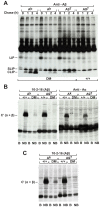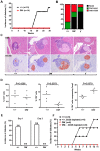The nonconventional MHC class II molecule DM governs diabetes susceptibility in NOD mice
- PMID: 23418596
- PMCID: PMC3572069
- DOI: 10.1371/journal.pone.0056738
The nonconventional MHC class II molecule DM governs diabetes susceptibility in NOD mice
Abstract
The spontaneous destruction of insulin producing pancreatic beta cells in non-obese diabetic (NOD) mice provides a valuable model of type 1 diabetes. As in humans, disease susceptibility is controlled by the classical MHC class II genes that guide CD4(+) T cell responses to self and foreign antigens. It has long been suspected that the dedicated class II chaperone designated HLA-DM in humans or H-2M in mice also makes an important contribution, but due to tight linkage within the MHC, a possible role played by DM peptide editing has not been previously tested by conventional genetic approaches. Here we exploited newly established germ-line competent NOD ES cells to engineer a loss of function allele. DM deficient NOD mice display defective class II peptide occupancy and surface expression, and are completely protected against type 1 diabetes. Interestingly the mutation results in increased proportional representation of CD4(+)Foxp3(+) regulatory T cells and the absence of pathogenic CD4(+) T effectors. Overall, this striking phenotype establishes that DM-mediated peptide selection plays an essential role in the development of autoimmune diabetes in NOD mice.
Conflict of interest statement
Figures






Similar articles
-
Loss of invariant chain protects nonobese diabetic mice against type 1 diabetes.J Immunol. 2006 Dec 1;177(11):7588-98. doi: 10.4049/jimmunol.177.11.7588. J Immunol. 2006. PMID: 17114428
-
Thymically-derived Foxp3+ regulatory T cells are the primary regulators of type 1 diabetes in the non-obese diabetic mouse model.PLoS One. 2019 Oct 24;14(10):e0217728. doi: 10.1371/journal.pone.0217728. eCollection 2019. PLoS One. 2019. PMID: 31647813 Free PMC article.
-
Antidiabetogenic MHC class II promotes the differentiation of MHC-promiscuous autoreactive T cells into FOXP3+ regulatory T cells.Proc Natl Acad Sci U S A. 2013 Feb 26;110(9):3471-6. doi: 10.1073/pnas.1211391110. Epub 2013 Feb 11. Proc Natl Acad Sci U S A. 2013. PMID: 23401506 Free PMC article.
-
The murine autoimmune diabetes model: NOD and related strains.Adv Immunol. 1992;51:285-322. doi: 10.1016/s0065-2776(08)60490-3. Adv Immunol. 1992. PMID: 1323922 Review. No abstract available.
-
NOD mice and autoimmunity.Autoimmun Rev. 2005 Jul;4(6):373-9. doi: 10.1016/j.autrev.2005.02.002. Epub 2005 Mar 29. Autoimmun Rev. 2005. PMID: 16081028 Review.
Cited by
-
A Missing Switch in Peptide Exchange for MHC Class II Molecules.Front Immunol. 2019 Oct 23;10:2513. doi: 10.3389/fimmu.2019.02513. eCollection 2019. Front Immunol. 2019. PMID: 31708929 Free PMC article. Review. No abstract available.
-
Type 1 diabetes associated HLA-DQ2 and DQ8 molecules are relatively resistant to HLA-DM mediated release of invariant chain-derived CLIP peptides.Eur J Immunol. 2016 Apr;46(4):834-45. doi: 10.1002/eji.201545942. Epub 2016 Jan 22. Eur J Immunol. 2016. PMID: 26707565 Free PMC article.
-
HLA-DMB restricts human T-cell leukemia virus type-1 (HTLV-1) protein expression via regulation of ATG7 acetylation.Sci Rep. 2017 Oct 31;7(1):14416. doi: 10.1038/s41598-017-14882-z. Sci Rep. 2017. PMID: 29089548 Free PMC article.
-
MHC Class II Protein Turnover In vivo and Its Relevance for Autoimmunity in Non-Obese Diabetic Mice.Front Immunol. 2013 Nov 25;4:399. doi: 10.3389/fimmu.2013.00399. Front Immunol. 2013. PMID: 24324466 Free PMC article. Review.
-
Comparative genetics: synergizing human and NOD mouse studies for identifying genetic causation of type 1 diabetes.Rev Diabet Stud. 2012 Winter;9(4):169-87. doi: 10.1900/RDS.2012.9.169. Epub 2012 Dec 28. Rev Diabet Stud. 2012. PMID: 23804259 Free PMC article. Review.
References
-
- Todd JA, Bell JI, McDevitt HO (1987) HLA-DQbeta gene contributes to susceptibility and resistance to insulin-dependent diabetes mellitus. Nature 329: 599–604. - PubMed
-
- Serreze DV, Leiter EH (2001) Genes and cellular requirements for autoimmune diabetes susceptibility in nonobese diabetic mice. Curr Dir Autoimmun 4: 31–67. - PubMed
-
- Todd JA, Wicker LS (2001) Genetic protection from the inflammatory disease type diabetes in humans and animal models. Immunity 15: 387–395. - PubMed
-
- Corper AL, Stratmann T, Apostolopoulos V, Scott CA, Garcia KC, et al. (2000) A structural framework for deciphering the link between I-Ag7 and autoimmune diabetes. Science 288: 505–511. - PubMed
-
- Latek RR, Suri A, Petzold SJ, Nelson CA, Kanagawa O, et al. (2000) Structural basis of peptide binding and presentation by the type 1 diabetes-associated MHC class II molecule of NOD mice. Immunity 12: 699–710. - PubMed
Publication types
MeSH terms
Substances
Grants and funding
LinkOut - more resources
Full Text Sources
Other Literature Sources
Medical
Molecular Biology Databases
Research Materials

